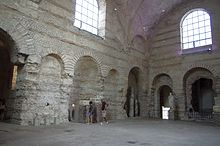
Back لوتيتيا Arabic لوتيتيا ARZ Лютэцыя Byelorussian Лутеция Bulgarian Lutècia Catalan Lutetia Czech Lutetia Danish Lutetia German Λουτέτια Greek Luteco Esperanto
 Baths of Cluny | |
| Alternative name | Lutetia Parisorum (Latin), Lutèce (French) |
|---|---|
| Location | Paris, France |
| Region | Gallia Lugdunensis, later Lugdunensis Senonia |
| Coordinates | 48°51′17″N 2°20′51″E / 48.85472°N 2.34750°E |
| Type | oppidum, later civitas |
| Area | 284 acres (115 ha)[1] |
| History | |
| Founded | c. 3rd century BC as a oppidum, refounded as civitas in 52 BC |
| Periods | 1st century BCE to 5th century |
Lutetia, (/luːˈtiːʃə/ loo-TEESH-ə,[2] Latin: [luːˈteːtia]; French: Lutèce [lytɛs]) also known as Lutecia[3] and Lutetia Parisiorum (/ ... pəˌrɪziˈɔːrəm/ pə-RIZ-ee-OR-əm;[2] Latin: [... pariːsiˈoːrʊ̃ː]; lit. 'Lutetia of the Parisii'), was a Gallo–Roman town and the predecessor of modern-day Paris.[4] Traces of an earlier Neolithic settlement (c. 4500 BC) have been found nearby, and a larger settlement was established around the middle of the third century BC by the Parisii, a Gallic tribe. The site was an important crossing point of the Seine, the intersection of land and water trade routes.
In the first century BC, the settlement was conquered by Romans and a city began to be built. Remains of the Roman forum, amphitheatre, aqueduct and baths can still be seen. In the fifth century it became the capital of the Merovingian dynasty of French kings, and thereafter was known as Paris.
Many artifacts from Lutetia have been recovered and are on display at the Musée Carnavalet.
- ^ Sciolino, Elaine (2019). The Seine: The River that Made Paris. W. W. Norton & Company. ISBN 978-0-393-60936-3.
- ^ a b "Lutetia". Collins English Dictionary. HarperCollins. Retrieved 2023-02-14.
- ^ This spelling is used by O. Seel (1961, 1968) in the Teubner text of Caesar's Gallic War: [1]
- ^ Guillaume, Valerie, "Musee Carnavalet-Histoire de Paris - Guide de Visite" (2021), p. 22-27


